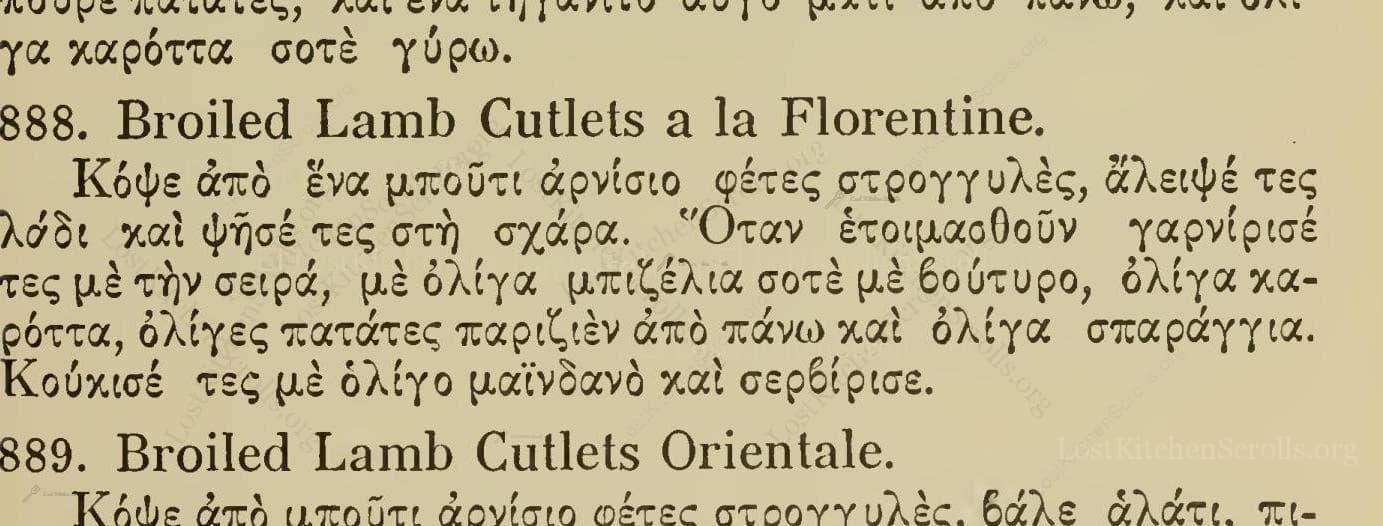Broiled Lamb Cutlets A La Florentine
"Broiled Lamb Cutlets A La Florentine"
From the treasured pages of Megale amerikanike mageirike dia mageirous kai oikogeneias
Written by Michael Gkines

Broiled Lamb Cutlets A La Florentine
"Κόψε ἀπὸ ἕνα μπούτι ἀρνίσιο φέτες στρογγυλές, ἄλειψέ τες λάδι καὶ ψῆσέ τες στὴ σχάρα. Ὅταν ἑτοιμασθοῦν γαρνίρισέ τες μὲ τὴν σειρά, μὲ ὀλίγα μπιζέλια σοτὲ μὲ βούτυρο, ὀλίγα κα- ρόττα, ὀλίγες πατάτες παριζιὲν ἀπὸ πάνω καὶ ὀλίγα σπαράγγια. Κούκισέ τες μὲ ὀλίγο μαϊνδανὸ καὶ σερβίρισε."
English Translation
"Cut round slices from a lamb leg, brush them with oil, and grill them. When they are ready, garnish them in order with some peas sautéed in butter, a few carrots, a few Parisian potatoes on top, and a few asparagus. Sprinkle them with a little parsley and serve."
Note on the Original Text
The recipe is written in the succinct, practical style typical of early 20th century cookbooks, assuming the reader has hands-on experience in the kitchen and is familiar with basic techniques. Ingredients are mentioned without exact quantities, focusing more on the method and sequence of garnishing the dish. Spelling and vocabulary are a mix of Katharevousa and Demotic Greek, often with phonetic borrowings for international culinary terms like 'Florentine.' Overall, instructions are sequential and direct, walking the reader step-by-step without unnecessary explanation.

Title
Megale amerikanike mageirike dia mageirous kai oikogeneias (1917)
You can also click the book image above to peruse the original tome
Writer
Michael Gkines
Era
1917
Publisher
Ekdotika Katastemata
Background
A sumptuous journey through early 20th-century Greek-American kitchens, this cookbook offers practical and time-tested recipes for savory dishes and delightful sweets—each crafted to suit the American system, yet infused with Greek tradition. A perfect companion for both family cooks and aspiring chefs.
Kindly made available by
Internet Archive
This recipe comes from early 20th century Greek-American culinary literature, published in 1917 in New York. The cookbook was designed to bring the new world of American cooking techniques and abundance to Greek immigrants and their families, blending Mediterranean flavors with American culinary style. Recipes like this show a sophisticated, continental influence—'à la Florentine' suggesting a nod both to Italian cuisine and to the international, urban tastes shaping Greek-American kitchens at the time. In a world between two cultures and two continents, the cookbook's recipes were bridges—familiar enough for Greek readers, but modernized and Americanized for their new setting.

Traditionally, the lamb cutlets would be prepared using a sharp knife to slice the meat and a metal grill or grate over a charcoal or wood fire. Classic cast iron or enamel sauté pans would be used for cooking the vegetables, and a small, sharp scoop might be employed for Parisienne potatoes. Simple saucepans would handle boiling or steaming of the other vegetables. All of this would likely be managed on a wood or coal-burning stove, with serving on robust platters.
Prep Time
20 mins
Cook Time
20 mins
Servings
6
We've done our best to adapt this historical recipe for modern kitchens, but some details may still need refinement. We warmly welcome feedback from fellow cooks and culinary historians — your insights support the entire community!
Ingredients
- 1 leg of lamb (approx. 3.3–4.4 lbs), sliced into 3/4–1 inch thick cutlets
- 2 tbsp olive oil (for brushing)
- 7 tbsp unsalted butter (for sautéing peas and potatoes)
- 1 cup fresh or frozen green peas (about 5.3 oz)
- 2–3 medium carrots (approx. 5 oz), boiled and sliced
- 3–4 medium potatoes (approx. 14 oz), Parisienne-cut if possible, or diced
- 8–12 asparagus spears (about 7 oz), trimmed
- Fresh parsley, finely chopped (about 1/3 oz)
- Salt and black pepper to taste
Instructions
- Begin by slicing a leg of lamb into thick, round cutlets, about 3/4–1 inch thick.
- Brush each piece generously with olive oil and grill over medium-high heat until done to your liking—about 3–4 minutes per side for medium.
- While the lamb cooks, prepare the garnishes: sauté a handful of green peas in a little butter, boil or steam a few carrots and slice them, cook some potatoes Parisienne-style (spooned into small balls and sautéed in butter), and steam asparagus spears until just tender.
- When ready to serve, arrange the lamb cutlets on a platter, top each with a little of the peas, carrots, potatoes, and asparagus, sprinkle with chopped parsley, and serve immediately.
Estimated Calories
550 per serving
Cooking Estimates
Preparing the vegetables and slicing the lamb takes about 20 minutes. Cooking the lamb and finishing the garnishes takes about 20 more minutes. Each generous serving contains about 550 calories, and this recipe makes 6 servings in total.
As noted above, we have made our best effort to translate and adapt this historical recipe for modern kitchens, taking into account ingredients nowadays, cooking techniques, measurements, and so on. However, historical recipes often contain assumptions that require interpretation.
We'd love for anyone to help improve these adaptations. Community contributions are highly welcome. If you have suggestions, corrections, or cooking tips based on your experience with this recipe, please share them below.
Join the Discussion
Rate This Recipe
Dietary Preference
Main Ingredients
Occasions

Den Bockfisch In Einer Fleisch Suppen Zu Kochen
This recipe hails from a German manuscript cookbook compiled in 1696, a time whe...

Die Grieß Nudlen Zumachen
This recipe comes from a rather mysterious manuscript cookbook, penned anonymous...

Ein Boudain
This recipe comes from an anonymous German-language manuscript cookbook from 169...

Ein Gesaltzen Citroni
This recipe, dating from 1696, comes from an extensive anonymous German cookbook...
Browse our complete collection of time-honored recipes



